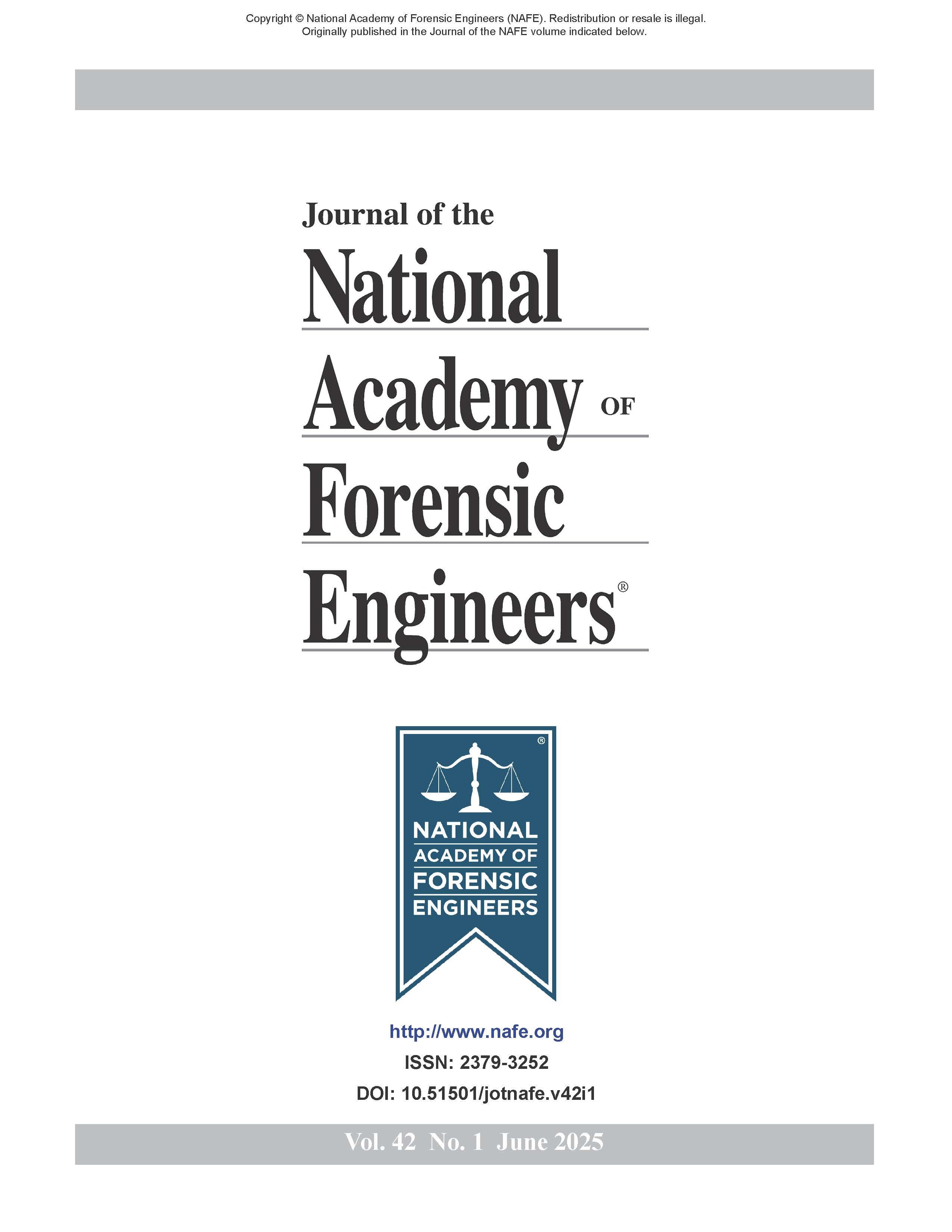Forensic Analysis of an Elevated Pool Vault
DOI:
https://doi.org/10.51501/jotnafe.v42i1.945Keywords:
Analysis, alkali-silica, ASR, Building code, construction, case study, craze cracks, defect, deficiency, demolition, forensic engineering, evaluation, finite element, ground-penetrating radar, GPR, gunite, Portland cement, investigation, map cracks, methodology, non-prestressed reinforcement, performancepetrography, performance, petrography, plaster, podium slab, pool, reaction, shear key, shotcrete, siliceous aggregates, slab, specification, variances, vaultAbstract
Distress observed in the plaster lining and gunite/shotcrete of a pool structure located within a podium slab on the third floor of an eight-story student housing building located in central Texas was determined to be causally related to the gunite/shotcrete mix. The gunite/shotcrete mix combined high alkali Portland cement with siliceous aggregates sufficient to generate alkali-silica reaction (ASR). Additional construction deficiencies associated with the thickness of the pool shell and the clear cover over the steel reinforcement were determined to have exacerbated the distress in the structure. Upon demolition of the pool structure, design deficiencies were subsequently identified in the recessed concrete vault that supported the pool structure. The identified design deficiencies included inaccurate structural design and analysis with finite element modeling software, inconsistencies in the thickness of the floor slab, omission of a shear key at the abutment/connection of the floor slab and the vault walls, and an inadequate amount of bonded, non-prestressed reinforcement in the floor slab. These deficiencies culminated in the demolition and reconstruction of the vault. This paper will explore the different parties involved in the design and construction of the project, the errors that resulted in deficient conditions, and the positions maintained by the different forensic engineering consultants representing the various parties.
References
ACI Committee 201, 2008, “Guide for Conducting a Visual Inspection of Concrete in Service,” American Concrete Institute, Farmington Hills, MI, 2008.
N. S. Admad and R. Hamid, "Relationship between Moisture Content and Dielectric Values of Concrete using Ground Penetrating Radar Method," Journal of Advanced Research Design, vol. 57, no. 1, pp. 21-33, 2019.
American Shotcrete Association, Compressive (Strength) Values of Pool Shotcrete [Online]. Available: https://shotcrete.org/wp-content/uploads/2020/01/ASAPositionPaper_PoolRec_1.pdf.
ASTM Standard C856-04, 2004, “Standard Practice for Petrographic Examination of Hardened Concrete,” ASTM International, West Conshohocken, PA, 2004, DOI: 10.1520/C0856-04.
E. Giannini, K. Folliard, J. Zhu, O. Bayrak, K. Kreitman, Z. Webb, and B. Hanson, “Non-Destructive Evaluation of In-Service Concrete Structures Affected by Alkali-Silica Reaction (ASR) or Delayed Ettringite Formation (DEF) – Final Report, Part 1”, Center for Transportation Research, The University of Texas at Austin, Austin, TX, Texas A&M Transportation Institute, College Station, TX, FHWA/TX-13/0-6491-1, 2013.
Michael, D.A. Thomas, Kevin J. Folliard, Benoit Fournier, Patrice Rivard, and Thano Drimalas, “Methods for Evaluating and Treating ASR-Affected Structures: Results of Field Application and Demonstration Projects – Volume I: Summary of Findings and Recommendations,” The Transtec Group, Austin, TX, FHWA-HIF-14-0002, 2013.
Bentley Systems, Inc., Exton, PA, USA, 2024. RAM Concept. Available: https://bentley.com/software/ram-concept/
ACI Committee 318, 2011, “Building Code Requirements for Structural Concrete (ACI 318-11) and Commentary,” American Concrete Institute, Farmington Hills, MI, 2011.
B. Eubanks, D. Patoskie, and G. Ryan, “Beyond the Building Code: A Forensic Approach to Construction Defect Evaluation Utilizing the Construction Variance Evaluation Methodology,” JotNAFE, vol. 41, no. 2, Jan. 2025.
Additional Files
Published
How to Cite
Issue
Section
License
Copyright (c) 2025 Journal of the National Academy of Forensic Engineers

This work is licensed under a Creative Commons Attribution-NoDerivatives 4.0 International License.
All rights © Journal of the National Academy of Forensic Engineers.
Full statement regarding the author's license of copyright to the NAFE is shown on the Copyright section of the Submissions Page.






